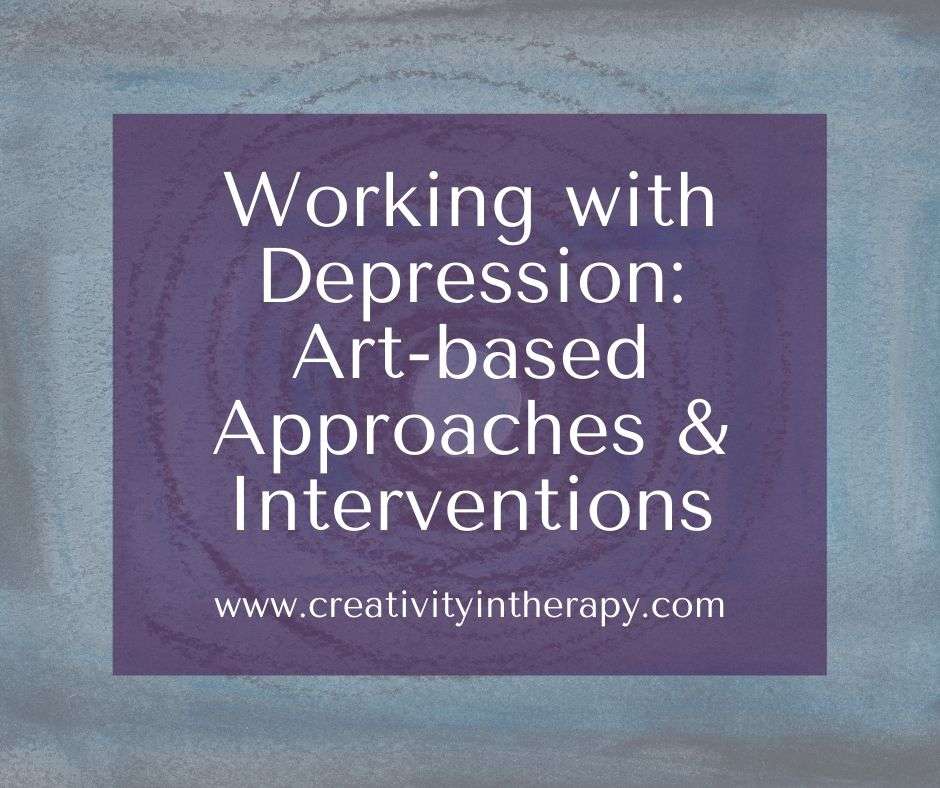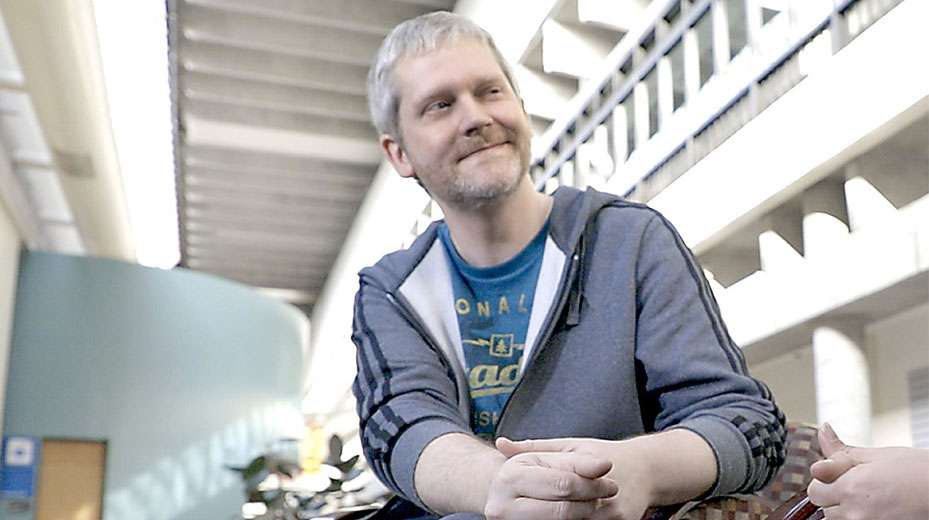
A question that I have gotten often through email is what art ideas I recommend for working with depression. So today I want to share a collection of some of the art directives and approaches that I use in working with clients who have depression.
First, however, let me offer a few reminders and disclaimers. Every client that we work with is unique. Please don’t take this list as a complete treatment plan for depression – not every activity on this list is appropriate for every client, there may be more that needs to be done beyond the art, and there may be other concerns that need to be addressed in treatment. Always suggest an art activity that responds to the needs of your client, the life factors impacting their depression, their own personal stuck points, and where they are in their healing journey. Also remember that I write from my own clinical experience and style, so this list includes directives that I often use in my own art therapy work but will not cover every possible approach or art idea related to depression.
I am also not covering formal art-based assessments in this post. However, some that would assess depression and coping include Draw a Person in the Rain, the Don Jones assessment, the lighthouse drawing, and Person Picking an Apple from a Tree. If you are interested in learning more about these, I encourage you to do some research and get additional training if needed.
Below, I have listed some of the goals that I may have with a client in session and possible ways to address them with the art. Many of these directives have been covered in previous blog posts, so I’ll link to the original posts throughout.
Art Therapy Directives for Depression
- Expressing emotions – Use the art to allow the client to express their depression and their emotions in general. That could be a general suggestion to “show me how you have been feeling,” a directive to do an abstract picture of depression (and/or other feelings), a feelings mandala, emotions as weather, or an image that externalizes the depression as a character. Creating masks can also be a powerful way for clients to express their emotions through art. The mask directive that I use most often is to “use the front of the mask to show how others see you and what emotions you allow yourself show; use the back to show those feelings you keep inside or the things that people often don’t see about you.”
- Imagine the future – We can use the art to help clients shift their focus from the present distress and problems to what they imagine or hope for the future. For some clients, this provides a helpful reminder that their current state will not last forever. For others thinking about the future can help them identify goals and helpful actions to take. And for others it may be an opportunity for them to express and acknowledge their current hopelessness about the future. Directives for imagining the future include – “what do you expect your life to be like in 5 or 10 years,” collage about hopes and goals for the future, vision boards, “what will your life be like when depression is gone,” draw/paint a feeling that you want to have more of, create a symbol of hope, and bridge or path drawings.
- Reinforce coping skills and positive activities – Art can serve multiple purposes when it comes to coping skills. Making art and being creative can be a coping skill in and of itself. Clients can use art both in session and at home as a way to have a positive distraction, an enjoyable activity, or a safe outlet for feelings. Art can also be a way to reinforce other coping skills. I have shared in the past about having clients create posters, collages, or coping cards about their coping skills.
- Use art to notice thinking patterns and practice more helpful thinking – Help clients to be aware of the thoughts that come up as they work on the art, especially unhelpful thoughts like self-criticism, perfectionism, and wanting to give up. Explore how these thoughts and beliefs show up in other parts of their life. Then use the art process as an opportunity to practice more helpful thoughts and mindsets, like self-acceptance, going with the flow, embracing imperfection, self-compassion, and approaching things playfully. To reinforce a new thought, mindset, or intention, you can also have the client create a piece of art about that thought.
- Strengthen connection and relationships – The most important aspect of healing in therapy is the relationship between the therapist and the client. In addition to all the other ways we build that relationship, the art provides a powerful opportunity for the client to be witnessed, supported, and accepted by the therapist. To help the client strengthen their sense of support and connection outside of the therapy room, we can also suggest art directives like map your support system or draw the people that love and support you. If work around healthy boundaries is needed to create better relationships, you can use the art to have clients visually depict their current boundaries and how they could be changed.
- Highlight the positives – To help clients look for the positive in themselves and their lives, use the art process to document some of these positives. Directives could include drawing, painting, or collaging – things that went well this week, your personal strengths, a happy memory, tree of strength activity, gratitude, and things you have accomplished. Many of these would provide great prompts for art journaling between sessions. (The book Positive Art Therapy Theory and Practice is a great source for more ideas.)
- Non-directive art – In thinking about art for healing, remember that we don’t always have to have a directive in art therapy. Non-directive art can allow the client to express what is on their mind, feel in control, and create things we never would have thought to suggest. Making art or crafts – whatever it is – can help clients build self-esteem, experience a positive sense of mastery, access flow, find meaning, lower stress levels, successfully work through something challenging, and connect with playfulness and joy.
I’d love to hear your thoughts! Do you have favorite art therapy directives or creative interventions for working with depression? Do you ever use formal art-based assessments to explore depression and coping? Share your ideas below.
Want more great art and writing prompts for exploring emotions, practicing mindfulness, developing healthy coping, increasing movement, and building healthy relationships? Be sure to check out my guided journal, The Balanced Mind.
Carolyn Mehlomakulu, LMFT-S, ATR-BC is an art therapist in Austin, Texas who works with children, teens, and families. For more information about individual therapy, child and teen counseling, family therapy, teen group therapy, and art therapy services, please visit: www.therapywithcarolyn.com.
This blog is not intended to diagnose or treat any mental health conditions. All directives, interventions, and ideas should be used by qualified individuals within the appropriate bounds of their education, training, and scope of practice. Information presented in this blog does not replace professional training in child and family therapy, art therapy, or play therapy. Art therapy requires a trained art therapist.
* Posts may include affiliate links (see full disclosure here). If you’d like to help support the blog without any extra cost to you, please click through on links and shop as you normally would. Your support is greatly appreciated!
~ Fritz Perls
Here is a popular internet list of art therapy activities originally posted up in 2011 by the Nursing School Blog. I have researched current links that reflect the most inspiring art therapy directives on the internet today, keeping them as close as possible to the original list.
Enjoy!
Shelley Klammer
Emotions
Deal with emotions like anger and sadness through these helpful exercises.
Relaxation
Art therapy can be a great way to relax. Consider these exercises if you’re looking to feel a little more laid back.
Happiness
Art can not only help you deal with the bad stuff, but also help you appreciate and focus on the good. Check out these activities all about reflecting on your personal happiness.
Portraits
Often, a great way to get to know yourself and your relationships with others is through portraits.
Trauma and Loss
These activities will ask you to face some unpleasant aspects of life, but with the goal of overcoming them.
Collaging
If you prefer to cut and paste rather than draw or paint, these projects are for you.
- Create a motivational collage. Collage a vision board. Fill it with images you find motivating.
- Create a face collage on a mask. We all wear masks of some sort. This project lets you showcase what’s in your mask and the face you put on for the world.
- Create a clutter collage. Are there things cluttering up your life? In this project, use words and pictures to show the clutter in your way.
- Create a calming collage. Choose images that you find soothing, calming or even meditative and combine them to create a collage to help you to relax.
- Collage a painting. Incorporate collage symbolism in a painting.
Self
Examine aspects if who you are and how you see the world through these art projects.
Gratitude
Here you’ll find a collection of projects that will help you be happy about what you have and express your gratitude for it.
Inside the Mind
Take a look inside your mind to see what’s going on with these projects.
- Create blot art. Like a classic Rorschach test, fold paper in half with paint or ink in the middle and describe what you see.
- Mind Mapping. Make a visual representation of your thoughts to figure out how your mind works.
- Make a dreamcatcher. Having bad dreams? Create this age-old tool for catching your dreams with a few simple tools.
- Draw your dreams. You can learn a lot from what goes on in your dreams, so keep a dream journal and use it for inspiration to draw or paint.
Miscellaneous
If you’re still looking for something to empower, help or soothe you, these projects may fit the bill.



